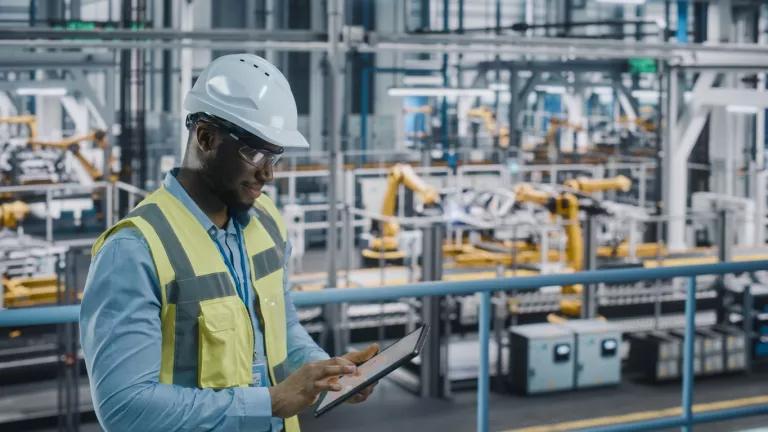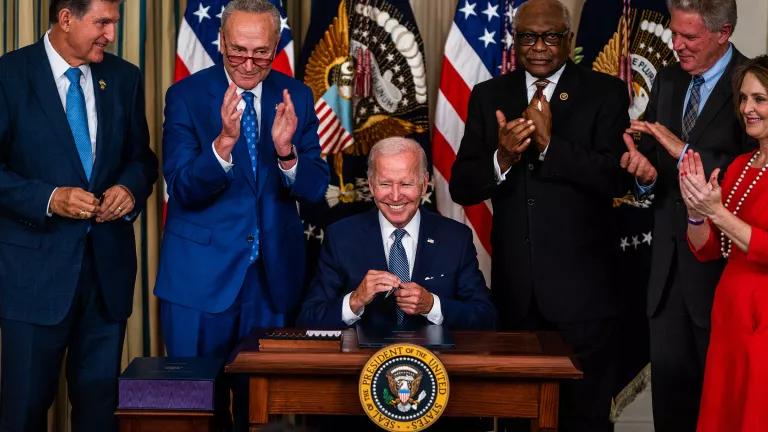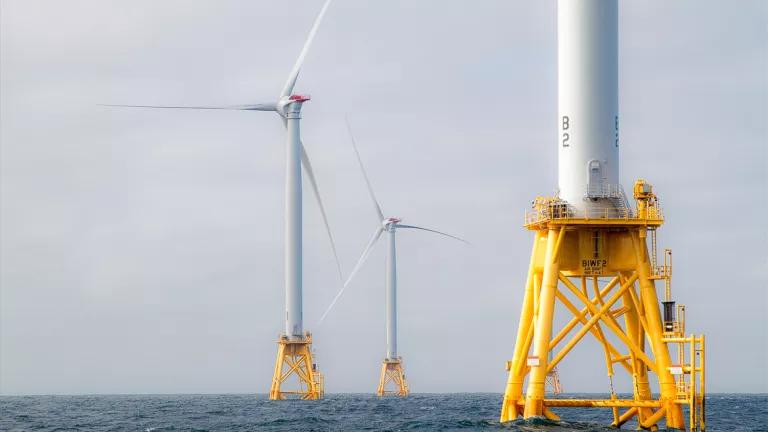Robust Appropriations for Innovation Are Needed to Build on Our Momentum
We call upon Congress to do four specific things in the context of FY24 appropriations for DOE.

istock/gorodenkoff
Appropriations season is ramping up once again, with the president’s budget request (PBR) released earlier this month and Hill offices in the process of developing their own requests for fiscal year 2024 (FY24). While climate and clean energy issues have increasingly been receiving the attention they deserve—such as through the much-needed infusion of funding provided in the bipartisan Infrastructure Investment and Jobs Act of 2021 (IIJA) and the Inflation Reduction Act of 2022—we still have a long road ahead of us to reach our target of net-zero, economy-wide greenhouse gas emissions by no later than 2050. Particularly in the wake of the Intergovernmental Panel on Climate Change releasing its sobering Synthesis Report this week, which United Nations Secretary-General António Guterres referred to as “a clarion call to massively fast-track climate efforts by every country and every sector and on every timeframe,” robust and sustained annual appropriations for clean energy innovation are more important than ever to accelerate progress and to ensure that the innovation ecosystem does not fall off a cliff in a few years when IIJA and Inflation Reduction Act programs expire.
Here are four specific things that we are calling upon Congress to do in the context of FY24 appropriations for the U.S. Department of Energy (DOE) and its programs focused on clean energy research, development, demonstration, and deployment:
1. Prioritize EERE top-line growth
DOE’s Office of Energy Efficiency & Renewable Energy (EERE) is the single-largest investor in clean energy technology development in the federal government, and it is focused on accelerating the research and development (R&D) of technologies and solutions that will boost U.S. economic competitiveness and job creation, advance national and energy security, reduce emissions of greenhouse gases and other harmful pollutants, and ensure that the clean energy economy benefits all Americans. EERE’s R&D activities span multiple critical industries and technologies, including clean electricity, sustainable transportation, advanced manufacturing, industrial decarbonization, advanced building technologies, low-carbon fuels, and hydrogen. As articulated in a recent coalition letter calling for continued increases in annual appropriations for EERE, much of the nearly $450 billion that IIJA and Inflation Reduction Act provided for clean energy over 5 to 10 years was oriented toward the demonstration and deployment phases of the innovation life cycle, as opposed to the earlier-stage R&D phases that are the core focus of EERE.
While the PBR asked for $3.8 billion for EERE (an 11 percent increase over enacted levels from last year), we’re calling upon Congress to allocate at least $4.5 billion for EERE, given its essential role in ensuring that the clean energy technologies of the future are invented and manufactured here within our own country.
2. Invest more in industry, buildings, and vehicles
There’s no doubt that decarbonizing our electricity supply is a necessary pillar of achieving net-zero emissions by mid-century. As such, we are pleased that the PBR calls for large increases for the EERE programs focused on renewable energy, including an ask for a 192 percent increase for the Wind Energy Technologies Office in order to significantly ramp up its efforts on offshore wind (such as the recently announced Floating Offshore Wind Shot that sets the ambitious goal of reducing the construction and operating cost of floating wind technologies by at least 70 percent by 2035 for deep sites located far offshore). With that said, the power sector is just one—albeit important—piece of the puzzle, and more attention needs to be given to end-use sectors that have received lesser focus in the past (namely, industry, buildings, and vehicles). Industry is responsible for 30 percent of U.S. economy-wide greenhouse gas emissions (see Figure 1), and that percentage is expected to increase through 2050, absent strong measures to switch to clean technologies. Innovation is critical because the manufacturing processes by which many heavy industrial materials are made currently depend primarily on burning fossil fuels in applications that can be difficult to electrify.
Furthermore, a large proportion of greenhouse gas emissions in the sector are from “process emissions,” which result from certain chemical reactions that produce goods from raw materials. As a result, off-the-shelf technologies and measures alone—such as improvements to energy and material efficiency—can reduce greenhouse gas emissions to some degree but cannot eliminate them. The technologies necessary to reach deeper levels of decarbonization are still in the early stages of development and deployment, and the federal government has an essential role to play in bringing these nascent technologies to maturity. Meanwhile, the buildings and transportation sectors each account for approximately 30 percent of economy-wide greenhouse gas emissions and present huge decarbonization opportunities through electrification and improvements in energy efficiency. The PBR recommends approximately $1.3 billion for the Industrial Decarbonization Crosscutting Initiative, a 25 percent increase over enacted levels from last year; $394 million for the Industrial Efficiency and Decarbonization Office (IEDO), a 48 percent increase; $348 million for the Building Technologies Office (BTO), a 5 percent increase; and $527 million for the Vehicle Technologies Office (VTO), a 16 percent increase. While all of these are insufficient, given the scale of the climate challenge (e.g., the Environmental Defense Fund’s 2021 analysis recommends that the appropriate annual appropriations levels should be $1.9 billion for BTO and $3.7 billion for VTO by next year), we also recognize that such large increases are unrealistic in the current budget environment.
As such, we are calling for the more reasonable levels of $1.5 billion for the Industrial Decarbonization Crosscutting Initiative, $500 million for the IEDO, $400 million for the BTO, and $527 million for the VTO (with the latter matching the PBR and the others coming in a little higher) while also noting that all of these must continue to see dramatic increases going forward.

Figure 1. Industry, buildings, and vehicles each account for approximately 30 percent of economy-wide greenhouse gas emissions.
3. Provide more support for state and local communities
DOE’s Office of State and Community Energy Programs (SCEP) works with state and local governments to accelerate the transition to a clean energy economy, including through facilitating investments in both clean energy generation and energy efficiency, as well as alternative transportation fuels and vehicles. SCEP encompasses the Weatherization Assistance Program and State Energy Program, which are long-standing programs that have delivered energy savings in every state across the country for more than 40 years. Moreover, these programs are Justice40 programs that are aiming to help address decades of underinvestment in disadvantaged communities. Considering the large amount of funding that will be flowing to states and local governments as a result of IIJA and the Inflation Reduction Act, SCEP’s programs and technical support are more important than ever to ensure that those funds are put to their highest use to reduce emissions, benefit local communities, and create jobs.
The PBR asked for $705 million (a 43 percent increase over enacted levels from last year), but we’d like to see it even higher at $800 million, given the critical role of this outreach and technical support to implementation of IIJA and Inflation Reduction Act.
4. Create a new appropriations account to facilitate clearer leadership on industrial decarbonization
When it comes to accelerating the innovation and adoption of cost-effective technologies that eliminate industrial greenhouse gas emissions, the Biden administration has been working to clarify its organization structure to enhance functionality, such as through the restructuring of the Advanced Manufacturing Office into the Advanced Materials and Manufacturing Technologies Office and the IEDO and through the build-out of DOE capabilities around new demonstration and deployment missions. While there are a lot of benefits to these changes, DOE’s industrial decarbonization activities are dispersed across several different offices and programs, including in EERE, the Office of Fossil Energy and Carbon Management, the Office of Science, and the Office of Clean Energy Demonstrations. A durable structure that provides clearer leadership could break down existing siloes and enhance coordination. This will be particularly important in administering the $6.3 billion in combined funding for industrial decarbonization demonstrations in IIJA and Inflation Reduction Act and ensuring effective implementation of the Industrial Decarbonization Roadmap that DOE released last year. DOE must ensure that the earlier-stage R&D programs are working in close collaboration with those later-stage demonstration and deployment programs to seamlessly move along promising industrial decarbonization technologies and processes from the laboratory to the manufacturing floor.
To that end, we’re advocating for a new appropriations account for Advanced Manufacturing and Industrial Emissions Coordination that would provide program direction (essentially, staff salaries and benefits) for DOE to establish a new coordination function that provides leadership for, and facilitates robust coordination across, all of its industrial decarbonization activities to ensure the effective development and multiyear implementation of the Industrial Decarbonization Roadmap strategy. Though it sounds similar to the aforementioned Industrial Decarbonization Crosscutting Initiative, which is in effect a roll-up of all relevant funding from different accounts, this is instead a request for dedicated funding for coordination.
Increased funding for clean energy innovation is popular and necessary
Data for Progress recently conducted polling that showed 79 percent of likely voters support increasing federal funding for clean energy innovation, with strong support across partisan identities. In other words, Congress should keep in mind that supporting the programs we have described above is popular. More importantly, those programs are necessary. Congress should provide robust appropriations for them in FY24.




